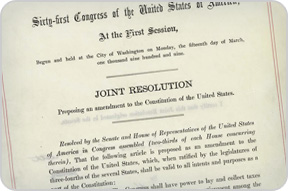
Theme 2: Taxes in U.S. HistoryLesson 3: Income Tax Issues

The federal income tax has not always been a part of the American taxation system. Early in our nation's history, the income tax was used only in times of war or national crisis to generate needed revenue.
In 1862, Congress passed the first federal income tax law to ease the burden of Civil War debts. This early tax was a progressive tax. It applied only to people who made more than $600, ensuring that the tax was based on citizens' ability to pay. The government relied on voluntary compliance with the income tax. Before it was repealed in 1872, this federal income tax provided nearly a quarter of the war revenue. By the twentieth century, the American economy had grown as a result of industrialization. The federal government supported more people and programs than ever. A small part of the population became very wealthy, but many more people remained poor. Congress again proposed a federal income tax to increase revenue and ease the burden of regressive taxes. The Sixteenth Amendment, ratified in 1913, allows the federal government to tax citizens' incomes directly. |
materials:Activities
Activity 1: History of the Federal Income Tax Find out how the federal income tax became a law by completing a timeline of important tax events. Activity 2: Calculating Taxes Calculate the federal income tax different groups would pay under the tax laws during the Civil War. Activity 3: Political Cartoons and Taxes Interpret the message behind political cartoons about taxes. Assessment
Complete the assessment page to test your understanding of History of the Federal Income Tax.
Links
Find more editorial cartoons on early tax issues at Editorial Cartoons.
|
| quick check |
|
Why did the government pass a federal income tax during the Civil War only to repeal it later?
|
| tax trivia |
|
Did You Know?
During the Civil War, the government placed taxes on all sorts of goods in order to generate revenue. Carriages, gold watches, musical instruments, pool tables, and yachts were among the items taxed.
Test your tax trivia knowledge by answering the multiple-choice question below. Click on the correct answer. To assess your answer, click the Check My Answers button. |
